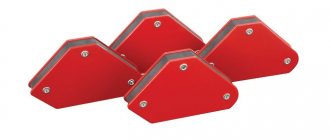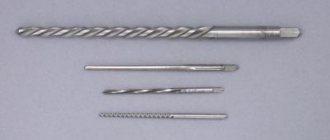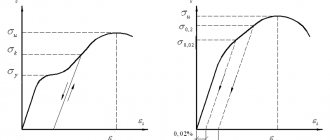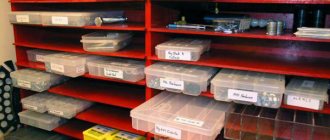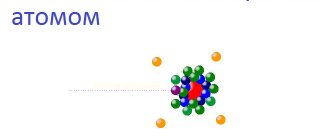Permalloy composition
Depending on the brand, permalloy contains a different ratio of nickel and iron. Standard composition:
- nickel - 81%
- iron - 19%
Sometimes they are alloyed with other metals to obtain the required properties. The metal was invented more than a century ago and was originally used to shield cables running over long distances. It was brought to our country much later and quickly gained popularity for the production of electronic equipment.
The composition of the metal is strictly standardized and does not allow deviations. Any inaccuracies lead to changes in characteristics, which is unacceptable for modern production. More information about the different types of permalloy can be found in GOST 10994-74.
Depending on their composition, permalloys are divided into:
- high-nickel, containing about 80% nickel. The most common product in this group is the 79NM alloy.
- Low-nickel, mostly consisting of iron. This metal has a lower magnetic permeability, but has excellent resistivity. The most commonly used alloy is 50НХС.
The following substances are most often used as additives: G – manganese; C – silicon; X – chromium; N – nickel; D – copper; A – nitrogen; F – vanadium; B – tungsten; E – selenium; K – cobalt; L - beryllium; M – molybdenum; P – boron; T – titanium; Yu – aluminum; C – zirconium; P – phosphorus; H – other elements.
Polymer materials
In those devices where, in addition to shielding the magnetic field, protection from mechanical damage and shock absorption are required, polymer materials are used. They are made in the form of gaskets made of polyurethane foam, covered with polyester film, based on acrylic adhesive.
In the production of liquid crystal monitors, acrylic seals made of conductive fabric are used. The acrylic adhesive layer contains a three-dimensional electrically conductive matrix made of conductive particles. Due to its elasticity, such a material also effectively absorbs mechanical stress.
Characteristics
The nickel content in the composition makes it resistant to corrosion and aggressive chemicals. Thanks to this, products made from iron-nickel alloys can be used in any conditions.
In addition, the material can be easily processed by all known methods without the use of complex and expensive equipment. Simple processing can be done even with hand tools. Due to this, permalloy can be used as a raw material for the production of any parts.
The alloy has high strength and ductility. However, the main qualities of this metal are high resistivity and magnetic permeability.
To obtain various properties, molybdenum, copper, silicon and other metals are added to the alloy. For example, to impart thermal stability, alloying with copper is carried out.
They are marked with a numerical-letter designation, where the first number indicates the percentage of nickel, then comes the letter “H” and the designations of additional components contained in permalloy. For example, the designation 79HM stands for permalloy with 79% nickel content, alloyed with molybdenum.
The performance characteristics of permalloy depend not only on its composition, but also on the processing method. Most often, a hardened composition is used, which is superior to the usual one in magnetic permeability and electrical resistance. It is worth noting that the properties also depend on the rate of heating and cooling during heat treatment.
Stellite
Stellites V2K and VZK - cast alloys based on cobalt (Table 6.10) are characterized by high wear resistance and increased toughness. They are produced in the form of rods with a diameter of 5–7 mm and a length of 250–300 mm and are used to strengthen various parts operating under conditions of intense abrasion at high temperatures. These alloys are applied by electric arc or gas welding. In addition to the above, nickel-based alloys include nichromes X15N60 and X2N80, the main property of which is heat resistance; nimonic-90 and nimonic-100, containing cobalt, molybdenum, niobium and having high heat resistance. These alloys are used to strengthen parts that operate for a long time at high temperatures, and are used for surfacing valve seats of internal combustion engines, sealing surfaces of pipeline fittings and other parts.
Stellites are characterized by high hardness, corrosion resistance and low friction coefficient. They are used to increase the wear resistance of machine parts, metallurgical plants, as well as for the manufacture of parts for steam pipelines operating under high pressure.
Stellites are fused using an oxy-acetylene flame onto parts made of carbon, low-alloy and stainless steels, as well as cast iron. Parts made of manganese steels are welded using the electric arc method, using electrode coating made of soluble glass and aluminum powder.
Stellites are mainly used for surfacing various wear parts. These alloys are produced in the form of rods with a diameter of 5–7 mm and a length of up to 250–300 mm. Parts are reinforced with stellites using an oxygen-acetylene flame or the electric arc method. In the latter case, cast carbide rods serve as electrodes.
Stellites are cast alloys of cobalt, chromium, tungsten, nickel and carbon. Stellite-like (sormite No. 1 and 2) are iron-based chromium-nickel alloys, similar in properties and structure to stellites, but having a different chemical composition.
Stellites also have high corrosion resistance. Good weldability allows the use of stellites for surfacing on tools (exposed to wear), due to which their durability is significantly increased.
Stellites are used only for the most critical and heavily loaded fittings. In other cases, alloys based on nickel and iron are used. Most of these alloys are developed on the basis of chromium-nickel austenitic steel G2Kh18N9T, which has high corrosion and erosion resistance.
| Design of the simplest working blade. |
Stellite is a cobalt-based alloy (60–65%), containing 25–28% chromium and 4–5% tungsten. It has high hardness and very high erosion resistance.
Stellites and their varieties of different origins, such as acrite, cardite, kelsite, giganite and perkite, like carbide alloys for cutting tools, have high hardness and good cutting properties.
Stellites are mainly used for surfacing various wear parts. These alloys are produced in the form of rods with a diameter of 5–7 mm and a length of up to 250–300 mm. Reinforcement of parts with stellites is carried out using an acetylene-oxygen flame or an electric arc method. In the latter case, cast carbide rods serve as electrodes.
Stellite fn sormite is used for surfacing parts that require mechanical processing to obtain a smooth and clean surface. The wear resistance of parts deposited with cast alloys increases several times.
Stellite, containing W and Co, has high corrosion resistance, in particular in sulfuric acid, high red resistance (up to 800 C), as a result of which it is used for surfacing cutting tools.
Stellites V2K and VZK, cast into rods, are used for surfacing tools and parts in order to increase their hardness and wear resistance. Surfacing is carried out using an acetylene-oxygen flame or an electric arc. The deposited layer has a hardness of HRC6Q - 62 and high red resistance (up to temperatures of 700 - 800 C), as well as relatively high corrosion resistance in a number of environments.
Stellites are a cobalt-based alloy containing tungsten, chromium and carbon.
Permalloy production
The production process of permalloy is technically complex. Most often it is supplied in the form of a thin strip. Permalloy rods, sheets and powder are also available. The process itself is a complex procedure requiring sophisticated industrial equipment and high precision manufacturing.
During production, permalloy must undergo heat treatment, otherwise the magnetic permeability will be extremely low. During the thermal process, the metal is heated to a temperature of 1300 ºC, after which there is a gradual cooling to 400 ºC.
Rolling is carried out in powerful rolling mills, where raw materials take the form of finished products. After this, the resulting products are fired and undergo testing and quality control. This metal is used in modern high-precision equipment, so defects and various deviations from state standards are not acceptable.
Materials
Most often, carbon steel screens are used for protection against magnetic fields, since they are highly technological in terms of welding, soldering, are inexpensive and are characterized by good corrosion resistance. In addition to them, materials such as:
- technical aluminum foil;
- soft magnetic alloy of iron, aluminum and silicon (Alsifer);
- copper;
- glass with conductive coating;
- zinc;
- transformer steel;
- conductive enamels and varnishes;
- brass;
- metallized fabrics.
Structurally, they can be manufactured in the form of sheets, meshes and foil. Sheet materials provide better protection, while mesh materials are more convenient to assemble - they can be joined together by spot welding in increments of 10-15 mm. To ensure anti-corrosion resistance, the mesh is coated with varnish.
Application
Permalloy is a difficult and expensive metal to produce. Therefore, they try to use it where it is impossible to do without it. However, despite this, it is widely used in electrical engineering and other industries.
Originally used to reduce distortion in telecommunication wires. Currently, it is impossible to imagine the manufacture of transformer cores and inductors without the use of permalloy. What is needed here is a material that is capable of accumulating energy in a magnetic field; it is difficult to find another metal that can do this as effectively.
Permalloy is able to obtain maximum induction even in a weak magnetic field. This makes it possible to manufacture from it sensor components for determining the magnetic field and various measuring instruments.
Modern pulse transformers use permalloy with maximum resistivity. Thanks to this, such devices are capable of converting various voltage characteristics with a small size.
Permalloy is also widely in demand for the manufacture of audio and high-frequency equipment. You will find this alloy in any amplifier, speaker heads and recording equipment. It is also a material for the production of protective housings for magnetically sensitive elements.
In medicine, permalloy is used to shield rooms for MRI and other magnetic procedures. Also indispensable for high-power electric microscopes.
Permalloy powder is used to coat various surfaces to give them the necessary properties. It is often used to spray a thick layer onto a metal base, which makes it possible to obtain a part with properties similar to those made from permalloy, but at a lower cost.
Property of ferromagnets
From a physics point of view, the most interesting material is a ferromagnet. There is a device that is a ring made of it. A wire is wound evenly in one layer on the device, through which an electric current flows. An electric field arises in this torus, coinciding in magnitude with the MF vector. As a result, the core will be magnetized.
If the magnetic induction of the body is plotted along the ordinate axis, and the current along the abscissa axis, then the following features can be found:
- at the initial moment of time the graph will increase at approximately an angle of 30 degrees;
- after reaching a certain value (1 T), the graph will sharply level off relative to B0.
From this we can conclude that a ferromagnet increases the magnetic field by about a thousand times. It turns out that magnetic permeability depends on the magnetizing field. If we draw perpendiculars from the transition point of the graph to the coordinate lines and draw a diagonal from it to the zero point, then the tangent of the angle to B0 will be equal to the permeability: μ = tan j. It turns out that at high magnetizing fields the magnetic field stops growing, that is, magnetic saturation exists.
If you take ferrite and magnetize it, and demagnetize the field by decreasing the field, then the demagnetization line will be different. When the external field disappears, the ferromagnet will remain magnetized.
There are two points on the loop:
- Bo is the residual magnetic induction that occurs after removing the electric field;
- Bc is the coercive force, the induction of the oppositely directed field.
Ferromagnets that have a wide hysteresis are called hard. These include hardened steel, alnico and magnico alloys, and neodymium. But there are also ferromagnets that are quite easy to remagnetize. Their hysteresis loop is narrow. Such materials are used in electric motors and transformers. They are called soft. Examples are annealed steel, permalloy.
Cable shielding
Protection against magnetic fields is necessary when laying cables. Electric currents induced in them can be caused by the inclusion of household appliances in the room (air conditioners, fluorescent lamps, telephones), as well as elevators in mines. These factors have a particularly great influence on digital communication systems operating using wide-bandwidth protocols. This is due to the small difference between the power of the useful signal and interference in the upper zone of the spectrum. In addition, the electromagnetic energy emitted by cable systems adversely affects the health of personnel working in the premises.
Crosstalk occurs between pairs of wires due to the presence of capacitive and inductive coupling between them. The electromagnetic energy of cables is also reflected due to inhomogeneities in their wave impedance and is attenuated in the form of heat losses. As a result of attenuation, the signal power at the end of long lines drops hundreds of times.
Currently, 3 methods of shielding cable routes are practiced in the electrical industry:
- The use of all-metal boxes (made of steel or aluminum) or the installation of metal inserts in plastic ones. As the field frequency increases, the shielding ability of aluminum decreases. The disadvantage is also the high cost of the boxes. For long cable routes, there is a problem of ensuring electrical contact of individual elements and their grounding to ensure zero potential of the box.
- Use of shielded cables. This method provides maximum protection since the sheath directly surrounds the cable itself.
- Vacuum deposition of metal onto a PVC channel. This method is ineffective at frequencies up to 200 MHz. The “quenching” of the magnetic field is tens of times less compared to laying the cable in metal boxes due to the high resistivity.
Mechanical properties
The thickness of the skin layer of various alloys depends on the frequency of the electromagnetic field.
Permalloy is a mechanically soft and corrosion-resistant material.
Application
ElekTrade-M company offers services in the design and production of magnetic shielding components and vacuum chambers with high permeability for low frequencies and static magnetic shields for use in various industries: aerospace, military and radio-electronic industries, oil and gas industry, energy, high-tech manufacturing, medicine , microscopy, quantum computers, GPS communications, science, education and other areas.
Vacuum chamber made of magnetic shielding material Mu-metal (permalloy)
Properties:
– mechanically soft and corrosion-resistant material,
– has a face-centered cubic lattice and cubic magnetic anisotropy,
– electrical resistivity 2×10−5 Ohm cm for alloy grade 81N,
– saturation induction up to 2 Tesla,
– has high magnetic permeability (maximum relative magnetic permeability μ ~ 100,000),
– magnetoresistive coefficient ranges from 2 to 4% (2% for fields of the order of 3.75 Oe or 300 A/m),
– has a coercive force,
– has almost zero magnetostriction and a significant magnetoresistive effect,
– the electrical resistance of permalloy varies within 5% depending on the strength and direction of the acting magnetic field.
Site Map
mo permalloy 79nm 65nt 81nma 50n 50np tape properties buy characteristics price magnetic permeability application in transformers in Moscow plant manufacturer scrap circle composition brand density purchase welding magnetic properties permeability core ring permalloy cores for sound sheets head hard rings permalloy wire manufacturers for making fluxgate core permalloy these alloys are relative magnetic permeability of permalloy
comments powered by HyperComments
This is interesting: Metal passivation - principle, purpose, types
Separation of substances
In the fifties of the nineteenth century, Faraday studied the influence of substances on magnetic fields. As a result, he came to the conclusion that all materials, without exception, affect the field. It follows that any substance is a source of its own MF, but only if it is placed in an external field. This phenomenon was called magnetization.
Based on the results of his research, Faraday divided all physical elements into three classes, giving a definition to each of them:
- Diamagnets. Substances whose permeability is slightly less than unity: μ < 1. These include all gases except oxygen, gold, silver, carbon in any crystalline modification, and bismuth. When these substances are placed in a magnetic field, the own vector of magnetic induction is directed in the direction opposite to the vector created by the current: B1↑↓B0. On the other hand, since the value of B1 is close to one, the modulus of the vector B1 is much less than the modulus of B0. It turns out that such a substance is magnetized very weakly and against an external field. An interesting fact is that diamagnetic substances, when placed in a coil with an MP, are pushed out of it.
- Paramagnetic materials. These include materials whose magnetic permeability is slightly greater than one. For example, alkali metals, aluminum, tungsten, magnesium, platinum. These substances are characterized by the fact that the module B1 is parallel to the vector B0, but the module B1 is less than the module of the vector B0.
- Ferromagnets. This class includes materials in which μ is much greater than one. Classic representatives of such substances are: iron, nickel, cobalt and their alloys. These substances are magnetized along the field. Moreover, B1 is much larger in absolute value than B0. Such materials greatly increase the magnetic field.
In a homogeneous MF, a body with a magnetic moment is affected only by a moment of force, which tends to rotate the dipole along the direction of the lines of force. In a non-uniform field, the dipole will be additionally acted upon by a force proportional to the magnitude of the dipole moment and field gradient: F = P (dB/dn) * cosj.
How to buy alloy 50НХС in Moscow
Retail and wholesale sales are carried out by ]Forankostal[/anchor] in the cities: Kazan, Perm, Kazan, Chelyabinsk, Samara, Voronezh, Novosibirsk, Moscow, Bryansk, Ryazan, Rostov-on-Don, Tyumen, Odintsovo, Belgorod and Moscow. We are ready to deliver rolled metal anywhere in Russia.
The cost of ordering 50НХС steel depends on the quantity and assortment. In order to find out prices or place an order, fill out the form on the website and we will contact you within a day. Managers will tell you in detail about the delivery conditions and help you choose the best grade of steel for your needs.
Our goal is to provide every potential buyer with favorable terms of cooperation and deliver quality products on time. Orders are accepted on the website around the clock and sent to the address after the details of the transaction have been clarified.
Products
The alloys discussed are also oriented towards different production methods.
- Stellite 6 is suitable for surfacing and cladding. Turning of stellite 6 is possible using carbide cutting tools.
- Type 1 is used in the same way. Can only be processed by grinding.
- Type 12 is oriented towards casting and is suitable for surfacing.
- PR-C27 is available in the form of rods and powder. Both options are used for surfacing.
- PR-VZK and PR-VZK-R are also oriented towards surfacing and are presented in the form of rods.
The degree of change is determined by the thickness of the deposited layer. For example, after 2 mm the carbon content for VZK is reduced from 1.46 to 1.02% and cobalt from 59.19 to 55.08%. Hardness reduced by 3–4 Rockwell.
Stellen parts are characterized by a high-quality smooth surface without defects, which increases resistance to abrasion and wear. Thus, in comparison with stellite products, stellene products have 40% better wear resistance.

